Impact Resistance of Styrene–Butadiene Rubber (SBR) Latex-Modified Fiber-Reinforced Concrete: The Role of Aggregate Size
Abstract
:1. Introduction
2. Experimental Program
2.1. Materials
2.1.1. Cement and Aggregates
2.1.2. SBR Latex
2.1.3. Polypropylene Fibers
2.2. Concrete Mixes
2.3. Detail of Specimens
- (1)
- Concrete cylinders of standard size of 150ϕ × 300 mm were used for determining mechanical properties, which include compressive strength, MOE, and split cylinder tensile strength.
- (2)
- Concrete cylinders of size of 40ϕ × 300 mmwere usedfor preparing disc specimens for the Charpy impact test.
- (3)
- The concrete specimens for the drop weight impact test are as follows:
2.4. Preparation of Test Specimens
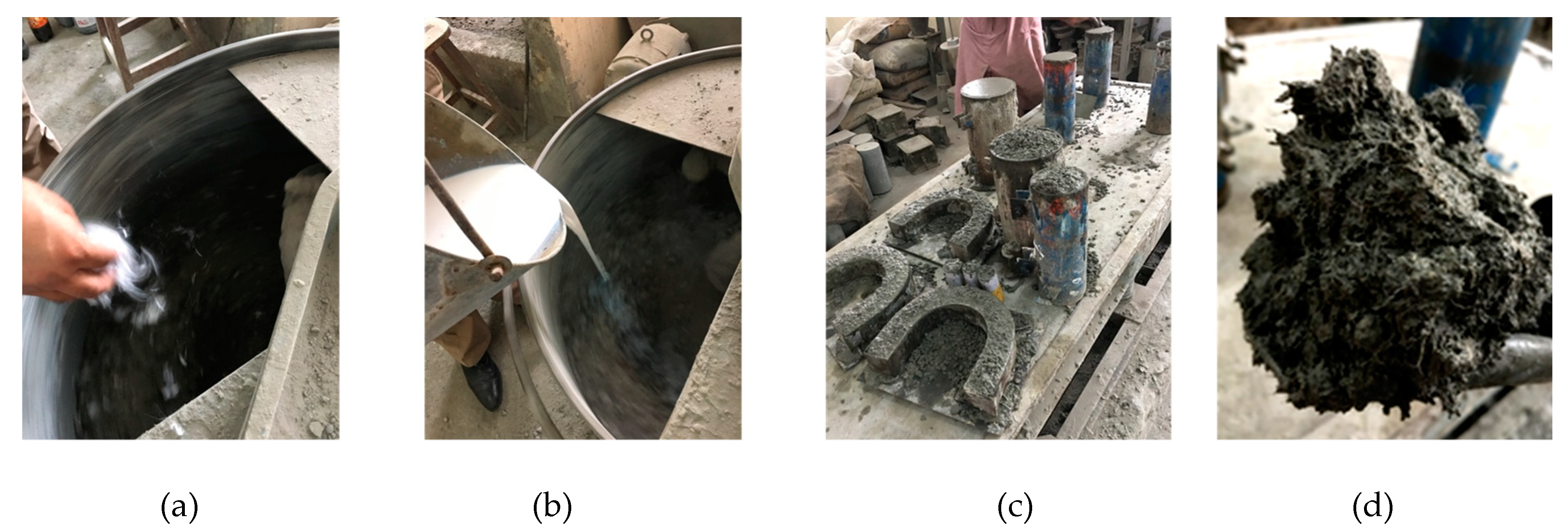
2.5. Testing Procedure
2.5.1. Mechanical Tests
2.5.2. Impact Tests
- (a)
- Drop weight impact test
- N1 = the drop weight potential energy at initial cracking;
- N2 = the drop weight potential energy at final failure;
- B1 = the number of blows at initial cracking;
- B2 = the number of blows at final failure.
- (b)
- The Charpy impact test
- M = the mass of fork = 22.9 kg;
- R = the radius of fork = 700 mm;
- θ1 = the free-fall angle;
- θ2 = the post-impact angle.
3. Results and Discussion
3.1. Compressive Strength and Modulus of Elasticity
Split Cylinder Tensile Strength (ft)
3.2. Impact Resistance
3.2.1. Charpy Impact Test
3.2.2. Drop Weight Test on 100 mm × 63.5 mm Concrete Disc
3.2.3. Drop Weight Test on U-Shape Specimen
4. Conclusions
- (1)
- The addition of polypropylene fibers has an insignificant effect on mechanical strength. However, with the addition of 4% SBR latex, strength values (compressive and tensile) increased. Further, the addition of 8% SBR latex had a negative impact on the mechanical properties of the polypropylene fiber-reinforced concrete.
- (2)
- The impact resistance of polypropylene fiber-reinforced concrete determined through the drop weight test on disc specimen was enhanced by the addition of 4% SBR latex. This enhancement was 1.7 to 2.9 times up to the initial crack, while it was 1.05 to 1.30 times the value of the control concrete mix at final failure.
- (3)
- For the concrete containing 4% SBR latex, after the initial cracking of disc specimen under impact loading, the presence of polypropylene fibers caused a 32% increase in energy absorption capacity up to final failure which was 55% in the case of the control mix.
- (4)
- With the increase in maximum aggregate size from 4.75 mm to 19 mm, the compressive strength and impact resistance of concrete (obtained through drop weight test on disc specimen) increased by 20% and 75%, respectively.
- (5)
- Experimental observations showed that the Charpy test is not reliable for large-size aggregate concrete with respect to the sample size used in this study.
Author Contributions
Funding
Institutional Review Board Statement
Informed Consent Statement
Data Availability Statement
Acknowledgments
Conflicts of Interest
References
- Ngo, T.; Mendis, P.; Gupta, A.; Ramsay, J. Blast loading and blast effects on structures, An overview. Electron. J. Struct. Eng. 2007, 7, 76–91. [Google Scholar]
- Sorensen, A.; McGill, W.L. What to look for in the aftermath of an explosion? A review of blast scene damage observables. Eng. Fail. Anal. 2011, 18, 836–845. [Google Scholar] [CrossRef]
- Kheyroddin, A.; Arshadi, H.; Ahadi, M.R.; Taban, G.; Kioumarsi, M. The impact resistance of Fiber-Reinforced concrete with polypropylene fibers and GFRP wrapping. Mater. Today Proc. 2021, 45, 5433–5438. [Google Scholar] [CrossRef]
- Yoo, D.-Y.; Banthia, N. Impact resistance of fiber-reinforced concrete—A review. Cem. Concr. Compos. 2019, 104, 103389. [Google Scholar] [CrossRef]
- Zaki, R.A.; AbdelAleem, B.H.; Hassan, A.A.A.; Colbourne, B. Impact resistance of steel fiber reinforced concrete in cold temperatures. Cem. Concr. Compos. 2021, 122, 104116. [Google Scholar] [CrossRef]
- Wang, Z.; Ma, G.; Ma, Z.; Zhang, Y. Flexural behavior of carbon fiber-reinforced concrete beams under impact loading. Cem. Concr. Compos. 2021, 118, 103910. [Google Scholar] [CrossRef]
- Xu, F.; Zhou, M.; Chen, J.; Ruan, S. Mechanical performance evaluation of polyester fiber and SBR latex compound-modified cement concrete road overlay material. Constr. Build. Mater. 2014, 63, 142–149. [Google Scholar] [CrossRef]
- Wang, R.; Wang PMm Li, X.G. Physical and mechanical properties of styrene–butadiene rubber emulsion modified cement mortars. Cem. Concr. Res. 2005, 35, 900–906. [Google Scholar] [CrossRef]
- Fu, Q.; Niu, D.; Zhang, J.; Huang, D.; Hong, M. Impact Response of Concrete Reinforced with Hybrid Basalt-Polypropylene Fibers. Powder Technol. 2018, 326, 411–424. [Google Scholar] [CrossRef]
- Hosseini, H.M.; Abdul-Awal, A.S.M.; Yatim, J.B.M. The Impact Resistance and Mechanical Properties of Concrete Reinforced with Waste Polypropylene Carpet Fibers. Constr. Build. Mater. 2017, 143, 147–157. [Google Scholar]
- Yin, S.; Tuladhar, R.; Collister, T.; Combe, M.; Sivakugan, N.; Deng, Z. Post-Cracking Performance of Recycled Polypropylene Fiber in Concrete. Constr. Build. Mater. 2015, 101, 1069–1077. [Google Scholar] [CrossRef]
- Ede, A.N.; Ige, A.O. Optimal Polypropylene Fiber Content for Improved Compressive and Flexural Strength of Concrete. IOSR J. Mech. Civ. Eng. (IOSR-JMCE) 2014, 11, 129–135. [Google Scholar]
- Thirumurugan, S.; Sekar, S.K. Impact Toughness Properties of Polymer Latex Modified Concrete Composites. Indian J. Sci. Technol. 2016, 1, 9. [Google Scholar] [CrossRef] [Green Version]
- Moavenzadeh, F.; Kuguel, R. Fracture of Concrete. J. Mater. 1969, 4, 497–519. [Google Scholar]
- Strange, P.C.; Bryant, A.H. The Role of Aggregate in the Fracture of Concrete. J. Mater. Sci. 1979, 14, 1863–1868. [Google Scholar] [CrossRef]
- Nallathambi, P.; Karihaloo, B.L.; Heaton, B.S. Effect of Specimen and Crack Sizes, Water/Cement Ratio and Coarse Aggregate Texture upon Fracture Toughness of Concrete. Mag. Concr. Res. 1984, 36, 227–236. [Google Scholar] [CrossRef]
- Kozul, R.; Darwin, D. Effects of Aggregate Type, Size, and Content on Concrete Strength and Fracture Energy. Struct. Eng. Eng. Mater. 1997, 6, 43. [Google Scholar]
- Karamloo, M.; Mazloom, M.; Payganeh, G. Effects of Maximum Aggregate Size on Fracture Behaviors of Self-Compacting Lightweight Concrete. Constr. Build. Mater. 2016, 123, 508–515. [Google Scholar] [CrossRef]
- ACI 544.2R-89. Measurement of Properties of Fiber Reinforced Concrete; American Concrete Institute: Indianapolis, IN, USA, 1989. [Google Scholar]
- Zhu, X.; Zhu, H.; Li, H. Drop-Weight Impact Test on U-Shape Concrete Specimens with Statistical and Regression Analyses. Materials 2015, 8, 5877–5890. [Google Scholar] [CrossRef] [PubMed] [Green Version]
- ASTM C150/C150M-20; Standard Specification for Portland Cement. ASTM International: West Conshohocken, PA, USA, 2020.
- ASTM C1042-99; Standard Test Method for Bond Strength of Latex Systems Used With Concrete By Slant Shear. ASTM International: West Conshohocken, PA, USA, 1999.
- ASTM C39/C39M-20; Standard Test Method for Compressive Strength of Cylindrical Concrete Specimens. ASTM International: West Conshohocken, PA, USA, 2020.
- ASTM C469/C469M-14; Standard Test Method for Static Modulus of Elasticity and Poisson’s Ratio of Concrete in Compression. ASTM International: West Conshohocken, PA, USA, 2014.
- ASTM C496/C496M-17; Standard Test Method for Splitting Tensile Strength of Cylindrical Concrete Specimens. ASTM International: West Conshohocken, PA, USA, 2017.
- ASTM A370-19; Standard Test Methods and Definitions for Mechanical Testing of Steel Products. ASTM International: West Conshohocken, PA, USA, 2019.

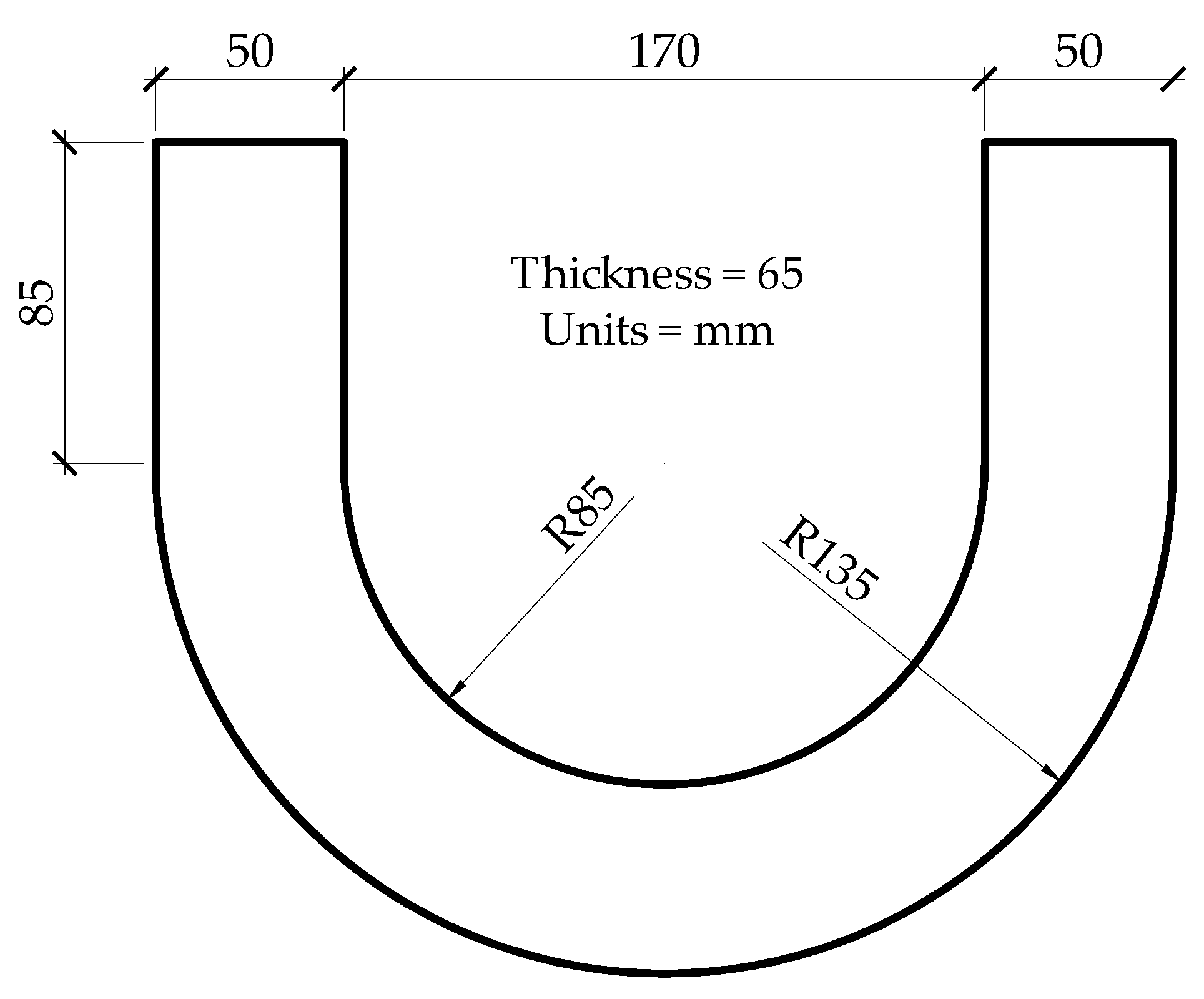
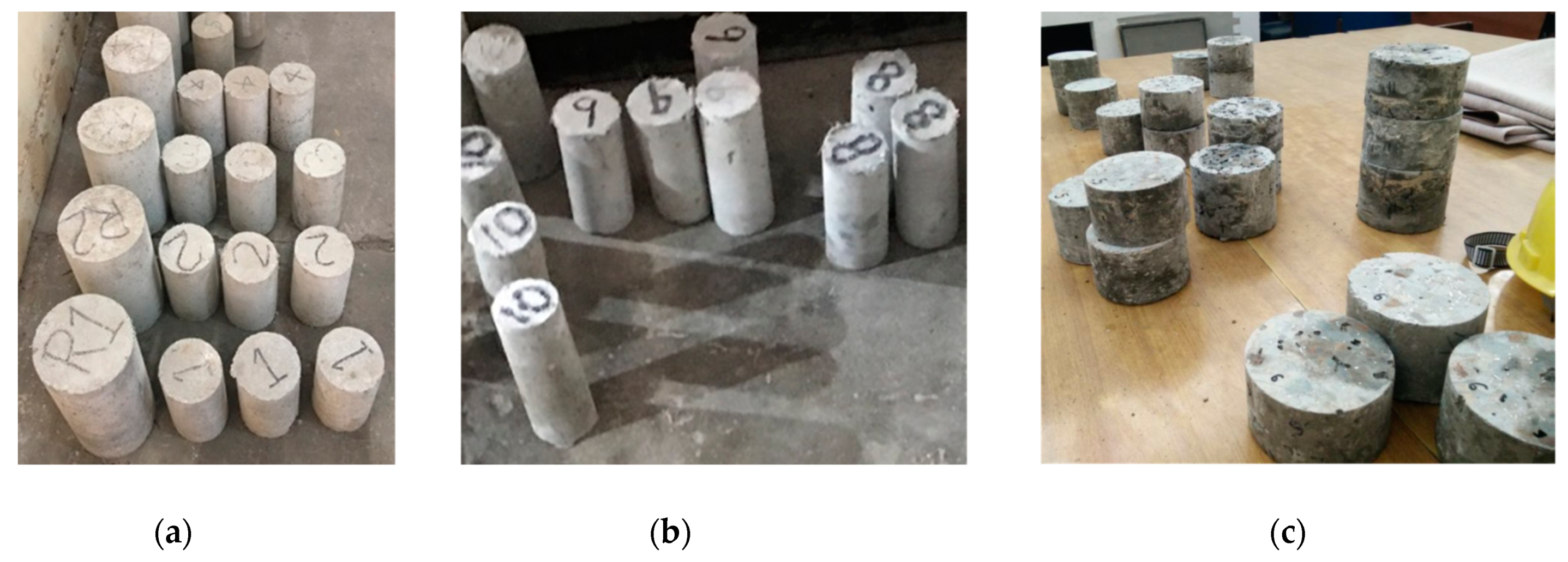

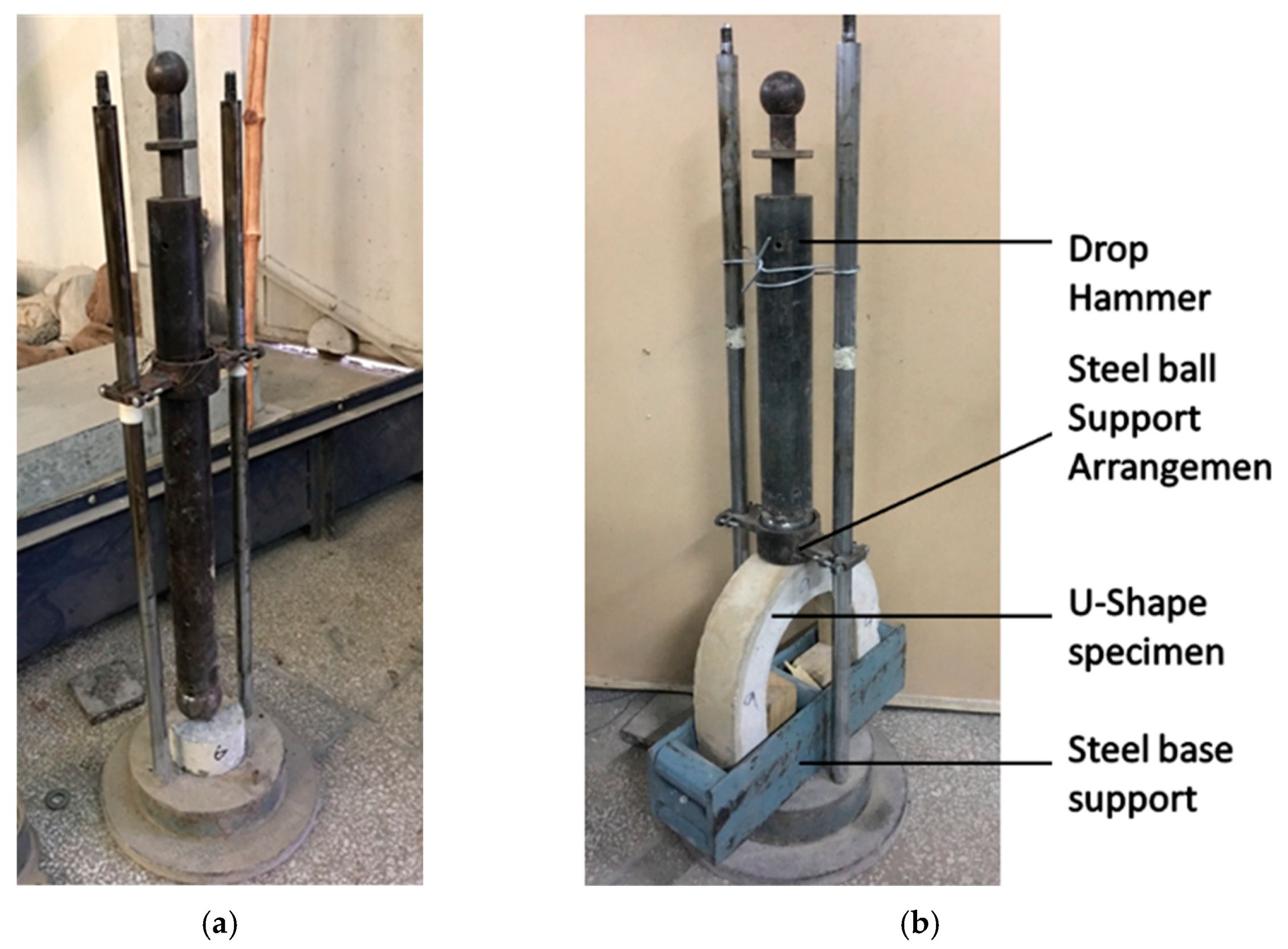

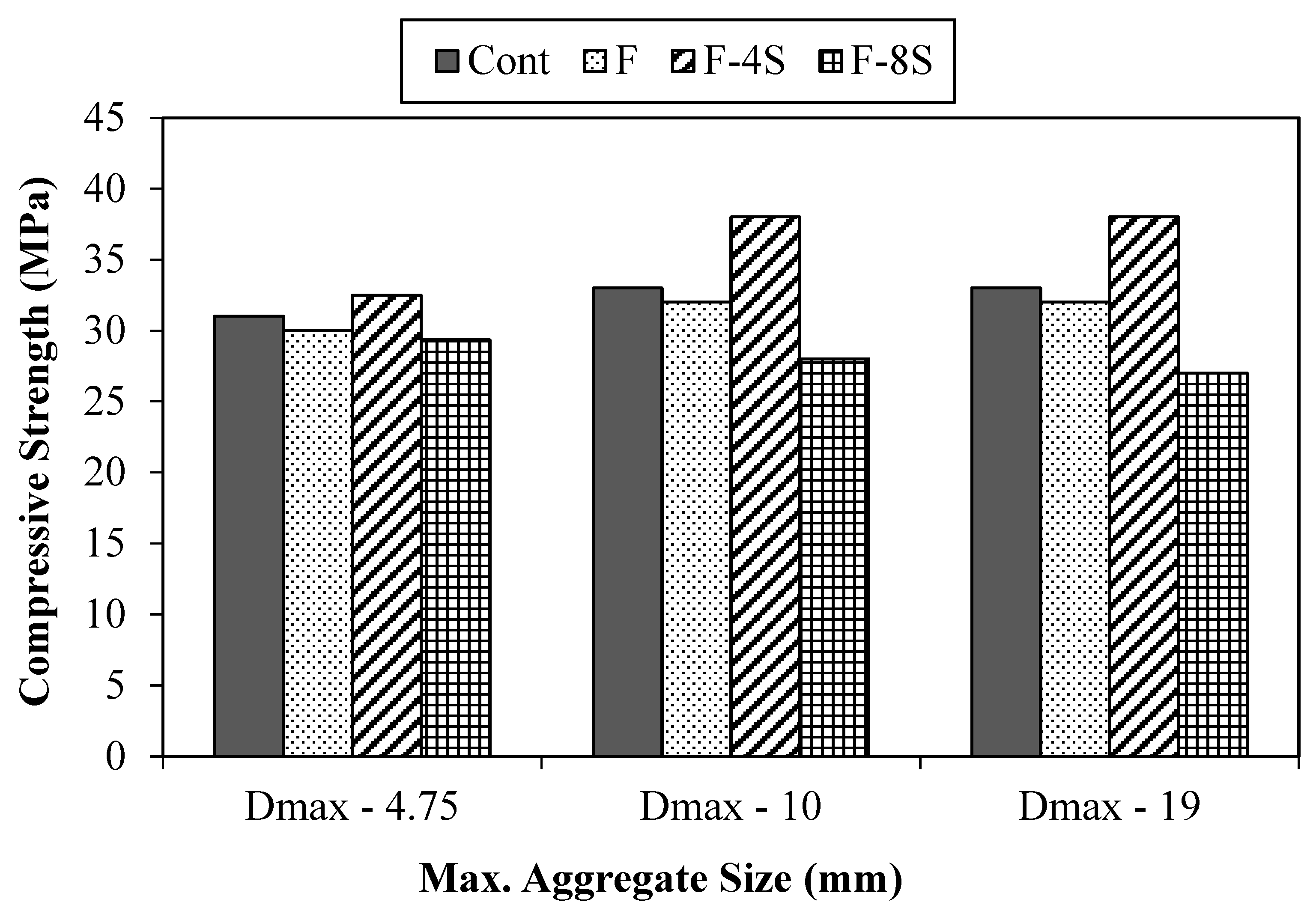
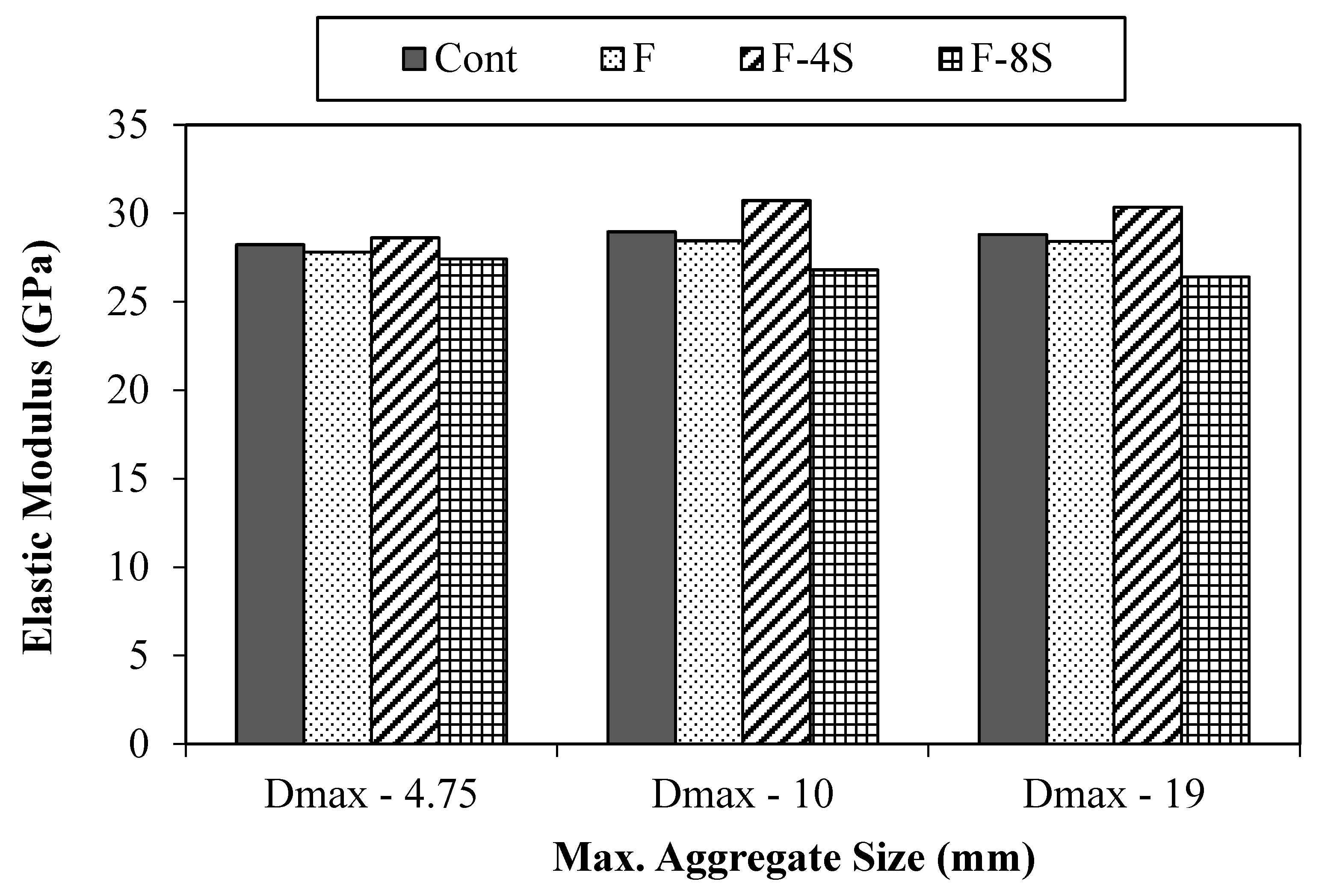
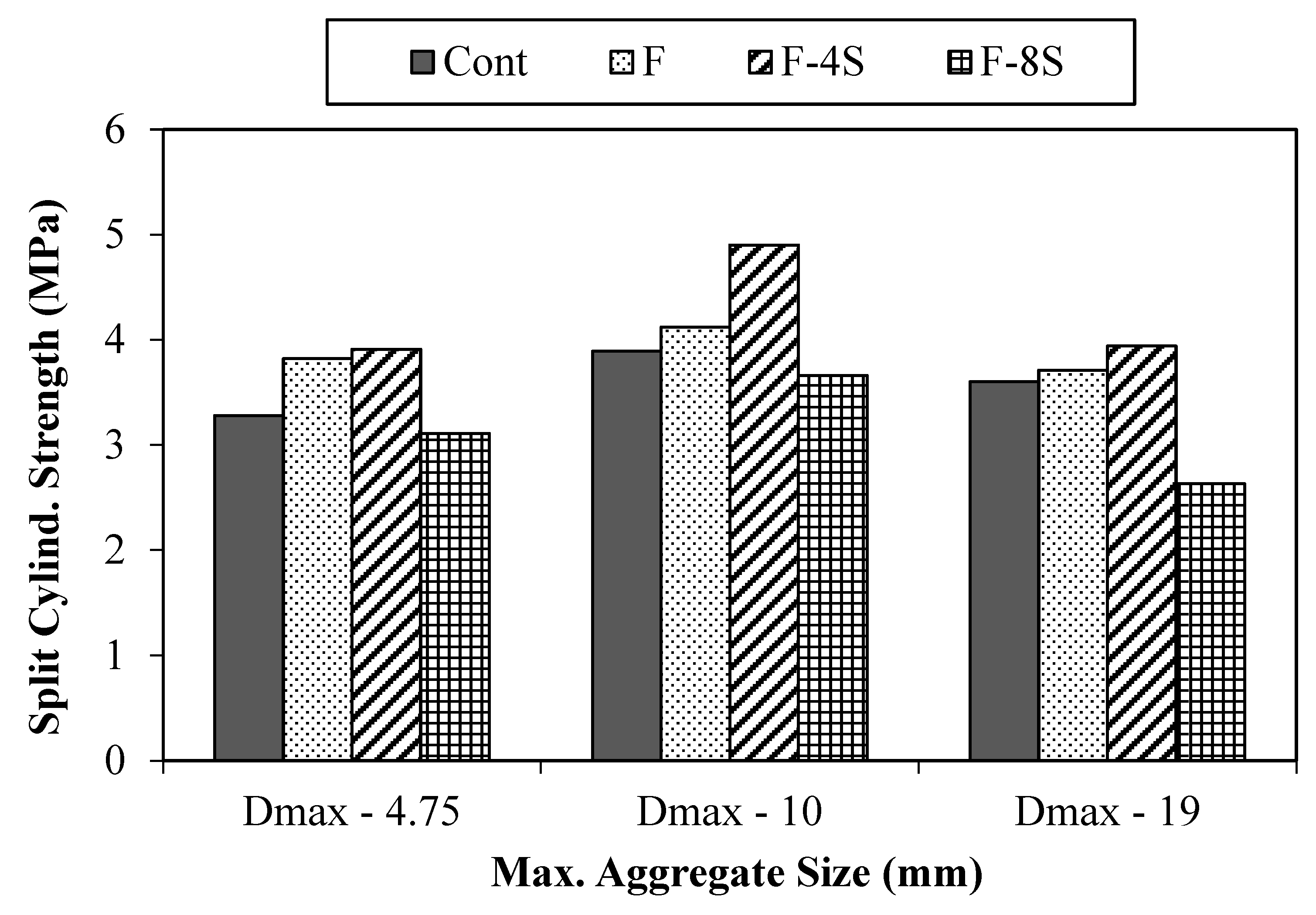

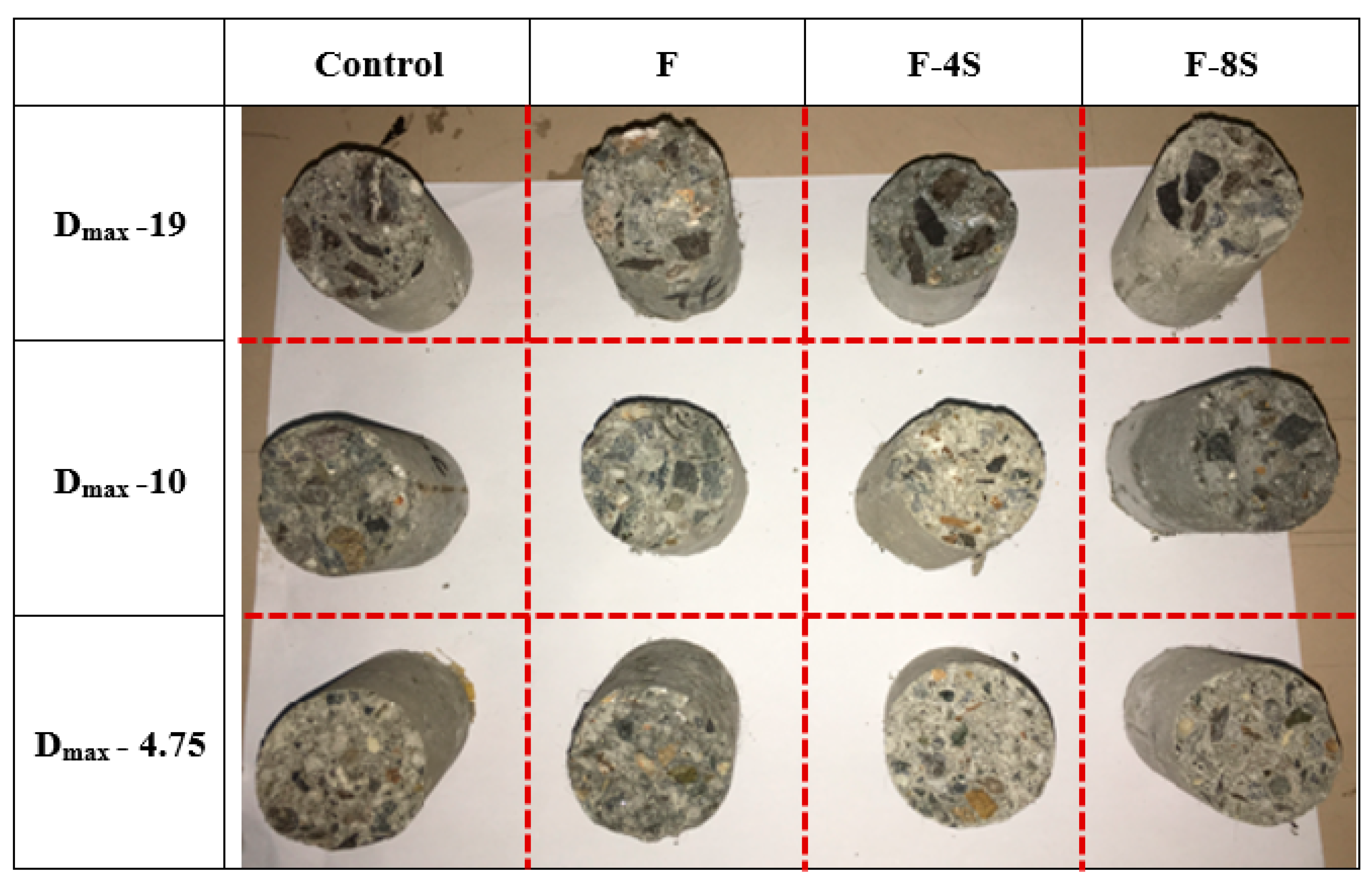
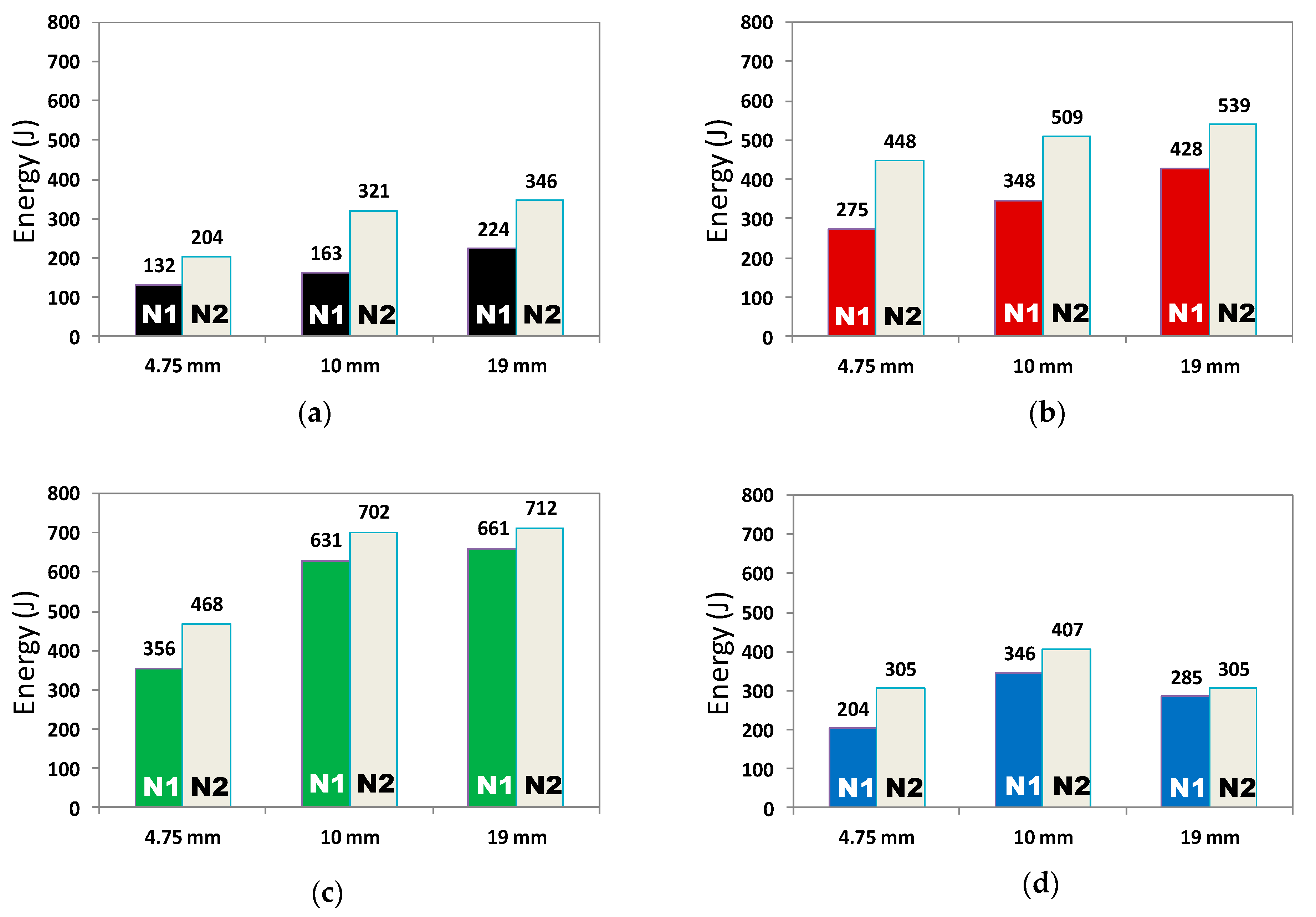
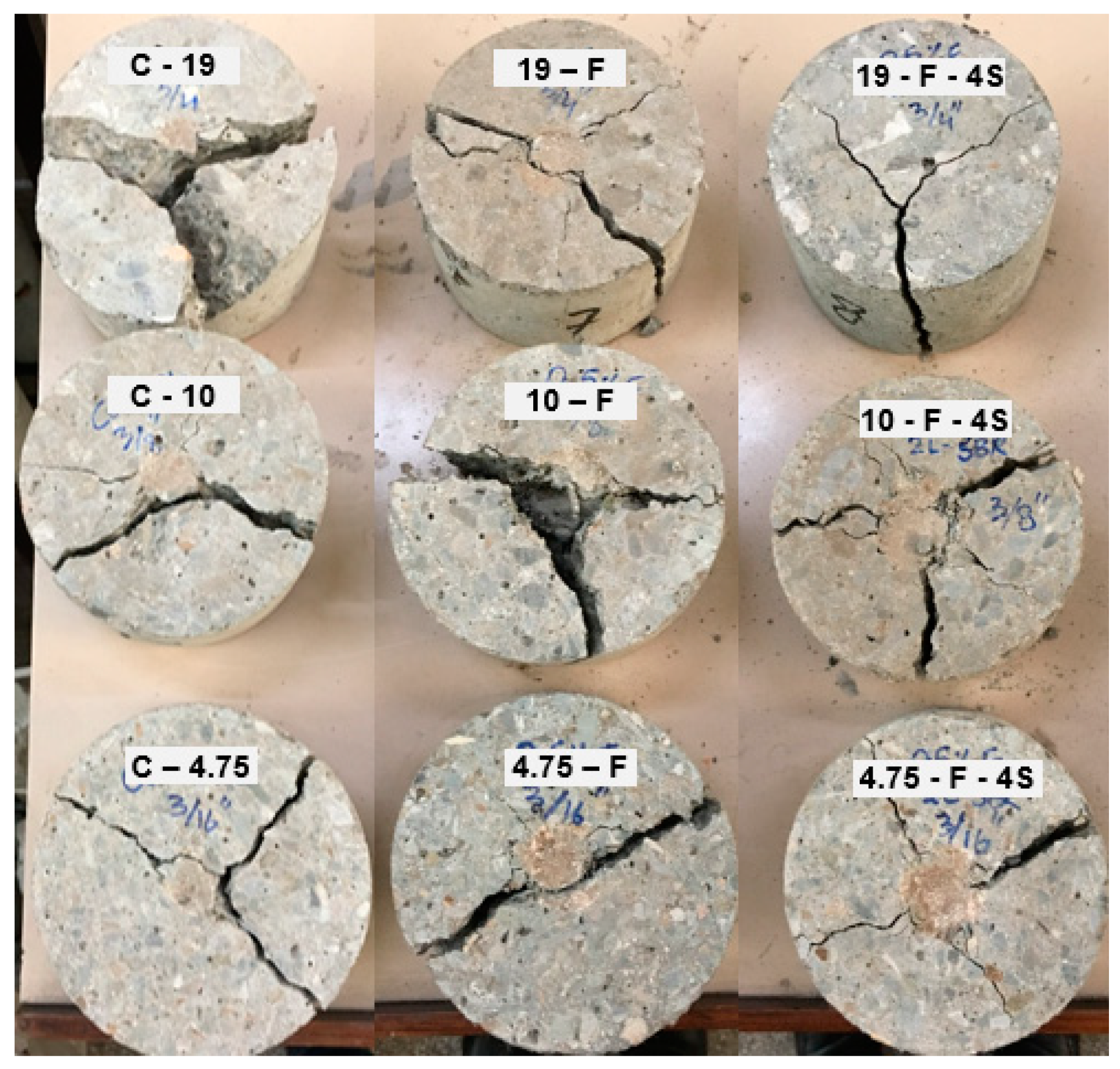

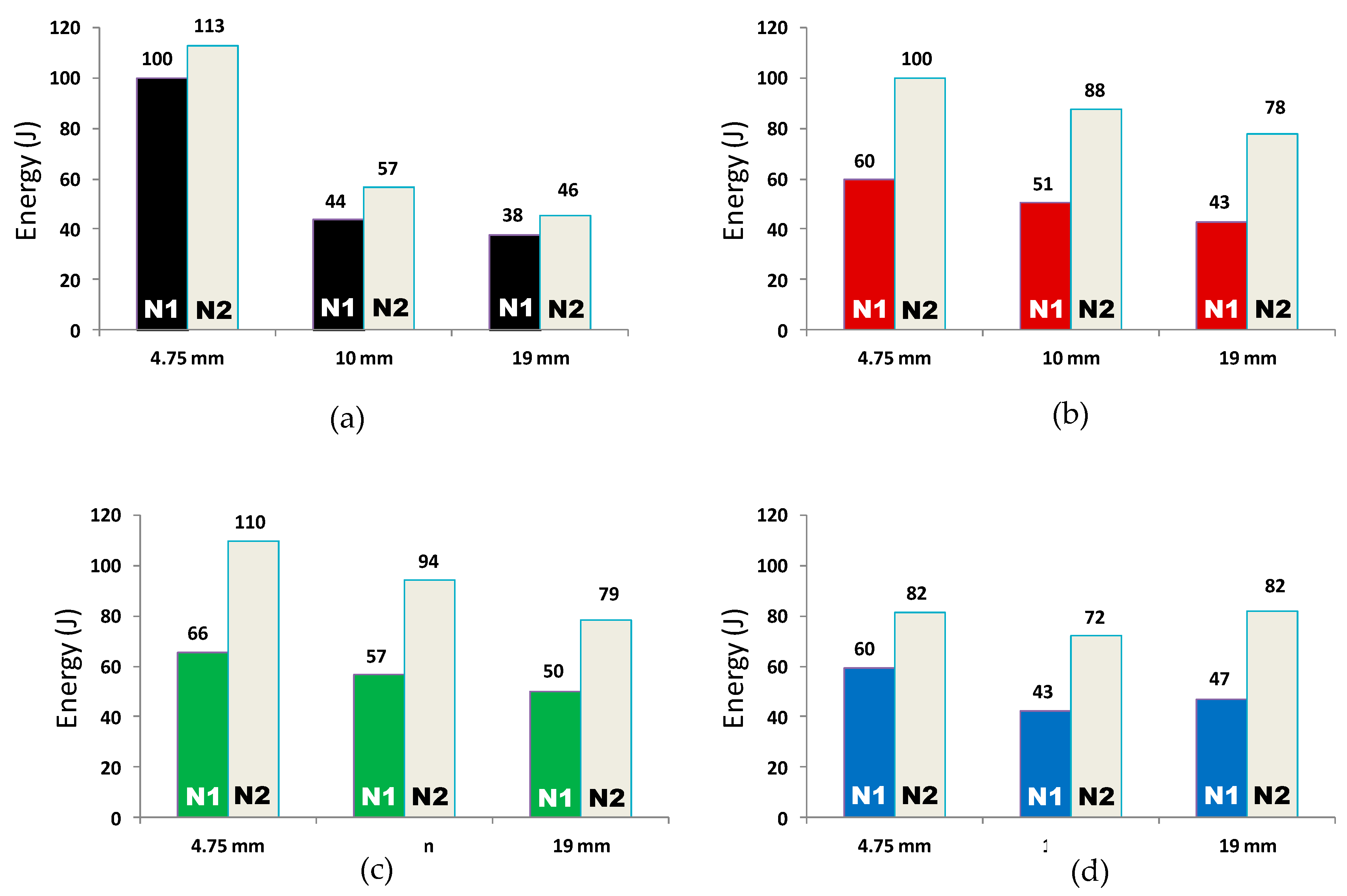

| Aggregate Type | ||
|---|---|---|
| Sargodha Crush | Lawrencepur Sand | |
| Bulk density (kg/m3) | 1630 | 1840 |
| Fineness modulus | - | 2.3 |
| Specific gravity | 2.72 | 2.60 |
| Voids (%) | 42.8 | 25.6 |
| Impact value (%) | 16.50 | - |
| Crushing value (%) | 29.80 | - |
| Property | Value |
|---|---|
| Density | 1 kg/L |
| Solids content (by weight) | 48% |
| pH | 10–11 |
| Property | Value |
|---|---|
| Density | 0.9 ± 0.01 kg/L |
| Fiber length | 12 mm |
| Fiber diameter | Approx. 15–30 micron |
| Absorption | Nil |
| Tensile strength | 300–450 MPa |
| Elongation at break | >15% |
| Softening point | 160 °C |
| Specific surface area | Approx. 200 m2/kg |
| Thermal conductivity | Low |
| Sr. No. | MIX ID | PP Fibers † | SBR Latex † | Cement kg/m3 | Coarse Aggregate kg/m3 | Fine Aggregate kg/m3 | Water kg/m3 | W/C | Max. Coarse Aggregate Size, mm |
|---|---|---|---|---|---|---|---|---|---|
| 1 | C-4.75 | -- | -- | 410 | 1230 | 615 | 164 | 0.4 | 4.75 mm |
| 2 | 4.75-F | 0.5 | -- | 410 | 1230 | 615 | 164 | 0.4 | |
| 3 | 4.75-F-4S | 4 | 410 | 1230 | 615 | 164 | 0.4 | ||
| 4 | 4.75-F-8S | 8 | 410 | 1230 | 615 | 164 | 0.4 | ||
| 5 | C-10 | -- | -- | 405 | 1220 | 610 | 163 | 0.4 | 10 mm |
| 6 | 10-F | 0.5 | -- | 405 | 1220 | 610 | 163 | 0.4 | |
| 7 | 10-F-4S | 4 | 405 | 1220 | 610 | 163 | 0.4 | ||
| 8 | 10-F-8S | 8 | 405 | 1220 | 610 | 163 | 0.4 | ||
| 9 | C-19 | -- | -- | 400 | 1190 | 595 | 160 | 0.4 | 19 mm |
| 10 | 19-F | 0.5 | -- | 400 | 1190 | 595 | 160 | 0.4 | |
| 11 | 19-F-4S | 4 | 400 | 1190 | 595 | 160 | 0.4 | ||
| 12 | 19-F-8S | 8 | 400 | 1190 | 595 | 160 | 0.4 |
| Specimen | Specimen Size | No. of Specimens | Tests to Be Performed | |
|---|---|---|---|---|
| Per Test | Total | |||
| Cylinder | 150ϕ × 300 | 2 | 24 | Compressive strength |
| Cylinder | 150ϕ × 300 | 2 | 24 | Split cylinder strength |
| Cylinder | 150ϕ × 300 | 2 | 24 | Modulus of elasticity |
| Cylinder | 40ϕ × 100 | 4 | 48 | Charpy impact yest |
| Cylinder | 100ϕ × 63.5 | 3 | 36 | Drop weight impact test |
| U-Shape | See Figure 2 | 3 | 36 | Drop weight impact test |
Publisher’s Note: MDPI stays neutral with regard to jurisdictional claims in published maps and institutional affiliations. |
© 2022 by the authors. Licensee MDPI, Basel, Switzerland. This article is an open access article distributed under the terms and conditions of the Creative Commons Attribution (CC BY) license (https://creativecommons.org/licenses/by/4.0/).
Share and Cite
Ashraf, M.R.; Akmal, U.; Khurram, N.; Aslam, F.; Deifalla, A.F. Impact Resistance of Styrene–Butadiene Rubber (SBR) Latex-Modified Fiber-Reinforced Concrete: The Role of Aggregate Size. Materials 2022, 15, 1283. https://doi.org/10.3390/ma15041283
Ashraf MR, Akmal U, Khurram N, Aslam F, Deifalla AF. Impact Resistance of Styrene–Butadiene Rubber (SBR) Latex-Modified Fiber-Reinforced Concrete: The Role of Aggregate Size. Materials. 2022; 15(4):1283. https://doi.org/10.3390/ma15041283
Chicago/Turabian StyleAshraf, Muhammad Rehan, Usman Akmal, Nauman Khurram, Fahid Aslam, and Ahmed F. Deifalla. 2022. "Impact Resistance of Styrene–Butadiene Rubber (SBR) Latex-Modified Fiber-Reinforced Concrete: The Role of Aggregate Size" Materials 15, no. 4: 1283. https://doi.org/10.3390/ma15041283
APA StyleAshraf, M. R., Akmal, U., Khurram, N., Aslam, F., & Deifalla, A. F. (2022). Impact Resistance of Styrene–Butadiene Rubber (SBR) Latex-Modified Fiber-Reinforced Concrete: The Role of Aggregate Size. Materials, 15(4), 1283. https://doi.org/10.3390/ma15041283







